Revaluation of Local Waste through an Ecotechnologies Strategic Plan: A Case Study with Digesters
Abstract
:1. Introduction
2. Materials and Methods
3. Results
3.1. User Perception
3.2. Process Acceptance
3.3. Perceived Benefits
3.4. Adoption of Ecotechnology
3.5. General Analysis of the Elements
4. Conclusions
Author Contributions
Funding
Institutional Review Board Statement
Informed Consent Statement
Data Availability Statement
Acknowledgments
Conflicts of Interest
Appendix A
Appendix A.1

Appendix A.2

Appendix A.3

References
- Kaza, S.; Yao, L.C.; Bhada, T.P.; Van, W.F. What a Waste 2.0: A Global Snapshot of Solid Waste Management to 2050; Urban Development: Washington, DC, USA, 2018. [Google Scholar]
- Coneval. Diagnóstico del Derecho a la Vivienda Digna y Decorosa 2018, Primera ed, 2018. Available online: https://www.coneval.org.mx/Evaluacion/IEPSM/Documents/Derechos_Sociales/Estudio_Diag_Vivienda_2018.pdf (accessed on 9 August 2021).
- UNESCO; WWAP. The United Nations World Water Development Report, Leaving No One Behind, the United Nations Human Rights Council (UNHRC), 2019. Available online: http://www.unwater.org/publications/world-water-development-report-2019/ (accessed on 22 September 2021).
- Schrader, K.K.; Liu, A. Informe del Banco Mundial: Los Desechos a Nivel Mundial Crecerán un 70% Para 2050, a Menos que se Adopten Medidas Urgentes, 2018. Available online: https://www.bancomundial.org/es/news/press-release/2018/09/20/global-waste-to-grow-by-70-percent-by-2050-unless-urgent-action-is-taken-world-bank-report (accessed on 22 October 2021).
- Organización Panamericana de la Salud OPS. Saneamiento Básico. Saneam. Rural y Salud/Guia Para Acciones a Niv. Local. 2010, 38. Available online: https://iris.paho.org/handle/10665.2/52823 (accessed on 4 September 2021).
- CONAGUA. Programa Nacional para Captación de Agua de Lluvia y Ecotecnias en Zonas Rurales (PROCAPTAR), 2017. Available online: https://www.gob.mx/conagua/acciones-y-programas/programa-nacional-para-captacion-de-agua-de-lluvia-y-ecotecnias-en-zonas-rurales-procaptar (accessed on 22 October 2021).
- Gómez, O.L.; Tacuba, S.A. La política de desarrollo rural en México? Existe correspondencia entre lo formal y lo real? The rural development policy in Mexico. Is there correspondence between the formal and the real? EconomíaUNAM 2017, 14. [Google Scholar] [CrossRef]
- Da Silva Lanna, M.C.; Viancelli, A.; Michelon, W.; Carvalho, S.V.C.; Dos Reis, D.D.A.; de Salles, L.A.F.; Sant’Anna, I.H.; Resende, L.T.; de Souza Ferreira, C.; das Chagas, I.A.; et al. Household-based biodigesters promote reduction of enteric virus and bacteria in vulnerable and poverty rural área. Environ. Pollut. 2019, 252, 8–13. [Google Scholar] [CrossRef] [PubMed]
- Mahmudul, H.M.; Rasul, M.G.; Akbar, D.; Narayanan, R.; Mofijur, M. A comprehensive review of the recent development and challenges of a solar-assisted biodigester system. Sci. Total Environ. 2021, 753, 141920. [Google Scholar] [CrossRef] [PubMed]
- Kulkarni, I.; Zang, J.W.; Leandro, W.M.; Parikh, P.; Adler, I.; da Fonseca-Zang, W.A.; Campos, L.C. Closed-Loop Biodigesters on Small-Scale Farms in Low- and Middle-Income Countries: A Review. Water 2021, 13, 2744. [Google Scholar] [CrossRef]
- RedBioLAC. RedBiolac Cuarta edición 2020; Rev. RedBioLAC, Uarta Edición: 2019. Available online: http://redbiolac.org/wp-content/uploads/2020/12/RedBioLAC-2020-3M.pdf (accessed on 22 October 2021).
- Kajau, G.; Madyira, D.M. Analysis of the Zimbabwe biodigester status. Procedia Manuf. 2019, 35, 561–566. [Google Scholar] [CrossRef]
- Rupf, G.V.; Bahri, P.A.; de Boer, K.; McHenry, M.P. Broadening the potential of biogas in Sub-Saharan Africa: An assessment of feasible technologies and feedstocks. Renew. Sustain. Energy Rev. 2016, 61, 556–571. [Google Scholar] [CrossRef]
- Li, Y.; Park, S.Y.; Zhu, J. Solid-state anaerobic digestion for methane production from organic waste. Renew. Sustain. Energy Rev. 2011, 15, 821–826. [Google Scholar] [CrossRef]
- Augusto de Lemos Chernicharo, C. Biological wastewater treatment: Anaerobic reactors. Belo Horiz. Dep. Eng. Sanitária e Ambient. Univ. Fed. Minas Gerais 2007, 5, 379. [Google Scholar]
- Sener. Reporte de Inteligencia Tecnológica “Biocombustibles Sólidos,” Mapas Ruta Tecnológica Para Los Centros Mex. Innovación En Energía. 2017, 73. Available online: https://www.gob.mx/cms/uploads/attachment/file/306072/Inteligencia_Tecnologica_BCS_220218.pdf (accessed on 17 December 2021).
- García-Lozano, M.; Lira, I.O.E.; Huber, D.H.; Balagurusamy, N. Spatial Variations of Bacterial Communities of an Anaerobic Lagoon-Type Biodigester Fed with Dairy Manure. Processes 2019, 7, 408. [Google Scholar] [CrossRef] [Green Version]
- Lee, J.; Han, G.; Shin, S.G.; Koo, T.; Cho, K.; Kim, W.; Hwang, S. Seasonal monitoring of bacteria and archaea in a full-scale thermophilic anaerobic digester treating food waste-recycling wastewater: Correlations between microbial community characteristics and process variables. Chem. Eng. J. 2016, 300, 291–299. [Google Scholar] [CrossRef]
- SEMARNAT. Informe de la Situación del Medio Ambiente en México. Naturales. Syria Stud. 2015, 7, 37–72. Available online: https://apps1.semarnat.gob.mx:8443/dgeia/informe15/tema/pdf/Informe15_completo.pdf (accessed on 17 December 2021).
- Cruz-Santos, M.M.; Macías-Franco, M.R.; Herrera-Medina, K.S.; Diaz-Ruiz, E.; Chandel, A.K.; da Santos, J.C.; da Silva, S.S.; Ramesh, P.T.; Sánchez-Muñoz, M.A. Governmental Policies to Promote Biogas Production, Boosting Role of Biogas in Economic Growth of Developing Nations. In Biogas Production: From Anaerobic Digestion to a Sustainable Bioenergy Industry; Balagurusamy, N., Chandel, A.K., Eds.; Springer International Publishing: Cham, Switzerland, 2020; pp. 447–469. [Google Scholar] [CrossRef]
- Acunzo, M.; Pafumi, M.; Torres, C.; Tirol, M. Manual de Comunicación Para el Desarrollo Rural. Organización de las Naciones Unidas Para La Alimentación y La Agricultura (FAO): Rome, Italy, 2016; Available online: https://www.fao.org/documents/card/es/c/62aae887-ab20-465a-aa37-1cbc15fcd868/ (accessed on 17 December 2021).
- Najjar, D.A.; Normandin, A.M.; Strait, E.A.; Esvelt, K.M. Driving towards ecotechnologies. Pathog. Glob. Health 2017, 111, 448–458. [Google Scholar] [CrossRef] [Green Version]
- Cervantes, G.I.; Pérez, R.H. Mitigation Strategies, the Biodigester Program in Yucatan, Mexico. Península 2018, 13, 235–262. [Google Scholar]
- Fuchs, C.; Diamantopoulos, A. Customer-perceived positioning effectiveness: Conceptualization, operationalization, and implications for new product managers. J. Prod. Innov. Manag. 2012, 29, 229–244. [Google Scholar] [CrossRef]
- FAO. Manual del Biogás, Proy. CHI/00/G32. 2011, 120. Available online: http://www.fao.org/docrep/019/as400s/as400s.pdf (accessed on 18 December 2021).
- Schunik, W.; Mora, F. El Posicionamiento, La Guerra por un Lugar en la Mente del Consumidor; Venez. Amolca, 2009; p. 44. Available online: https://docplayer.es/29449624-El-posicionamiento-autores-fabiola-mora-walter-schupnik-la-guerra-por-un-lugar-en-la-mente-del-consumidor.html (accessed on 18 December 2021).
- Hernández, W.R. Branding sustentable. Rev. Cent. Investig. Univ. Salle 2012, 10, 95–99. [Google Scholar]
- Ortega, M.S.; Ceballos, P.B. Design Thinking: Lidera el Presente. Crea el Futuro; Esic Editorial: Pozuelo de Alarcón, Madrid, 2015. [Google Scholar]
- CONEVAL. Consejo Nacional de Evaluación de la Política de Desarrollo Social, Informe de Pobreza y Evaluación, Querétaro 2018, 2020, 117. Available online: https://bit.ly/2QexnU2 (accessed on 18 December 2021).
- IMPLAN. Plan Estratégico del Municipio de Querétaro a Largo Plazo. Inst. Munic. Planeación 2020. Available online: http://implanqueretaro.gob.mx/v2/im/st/0/mod_p2050/MunicipioDeQueretaro_PLAN2050.pdf (accessed on 18 December 2021).
- CONEVAL. Consejo Nacional de Evaluación de la Política de Desarrollo Social, Informe Anual Sobre la Situación de Pobreza y Rezago Social. Inf. Anu. Sobre La Situación Pobr. Y Rezago Soc. 2018, 2. Available online: http://www.dof.gob.mx/SEDESOL/Chiapas_108.pdf (accessed on 22 February 2022).
- SEDESOL. Annual Report on Poverty and Social Backwardness 2016, Tequisquiapan, Querétaro Tequisquiapan. Querétaro 2016, 2015–2016. Available online: http://diariooficial.gob.mx/SEDESOL/2016/Queretaro_017.pdf (accessed on 5 March 2022).
- Spiegel, M.R.I.; John, J.; Srinivasan, R. Probabilidad y Estadística/Murray R. Spiegel, John J. Schiller y R. Alu Srinivasan., 2013. Available online: https://eduvirtual.cuc.edu.co/moodle/pluginfile.php/523771/mod_resource/content/1/EstadisticadeSchaum.pdf (accessed on 22 February 2022).
- Coca, M. Importancia y Concepto del Posicionamiento una Breve Revisión Teórica. Perspectivas 2007, 20, 105–114. [Google Scholar]
- Keller, P.A.; McGill, A.L. Differences in the relative influence of product attributes under alternative processing conditions: Attribute importance versus attribute ease of imagability. J. Consum. Psychol. 1994, 3, 29–49. [Google Scholar] [CrossRef]
- Long, Y.; Ceschin, F.; Harrison, D.; Terzioğlu, N. Exploring and Addressing the User Acceptance Issues Embedded in the Adoption of Reusable Packaging Systems. Sustainability 2022, 14, 6146. [Google Scholar] [CrossRef]
- Merlo, F.J.V. La promoción de ventas y los beneficios percibidos por el consumidor. Rev. Eur. Dir. Y Econ. La Empres. 2005, 14, 209–222. [Google Scholar]
- Barrie, C.A.; Gallo, M.P.; Pérez, J.A.P. Análisis de la Innovación de Marcas de Distribuidor y de su Influencia en la Aceptación de Productos Nuevos de Gran Consumo en España; Universidad Complutense de Madrid: Madrid, Spain, 2009. [Google Scholar]
- Martínez, J.V. Perfil de valor de marca y la medición de sus componentes. Acad. Rev. Latinoam. Adm. 2008, 41, 69–89. [Google Scholar]
- Bocken, N.M.P.; Bom, C.A.; Lemstra, H. Business-led sustainable consumption strategies: The case of HOMIE. In Proceedings of the 18th ERSCP Conference, Skiathos Island, Greece, 1–5 October 2017. [Google Scholar]
- Bhamra, T.; Lilley, D.; Tang, T. Design for Sustainable Behaviour: Using Products to Change Consumer Behaviour. Des. J. 2011, 14, 427–445. [Google Scholar] [CrossRef]
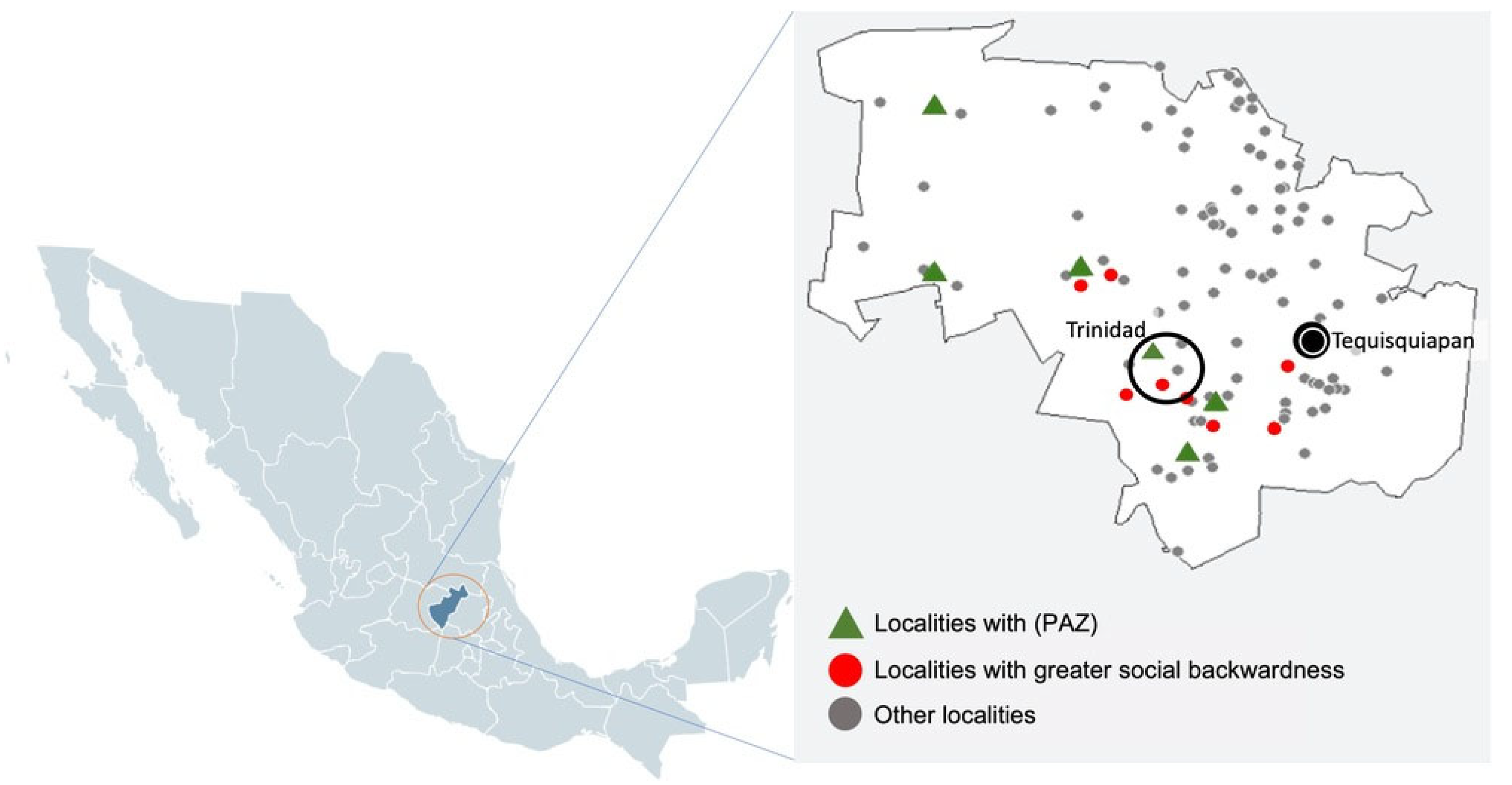

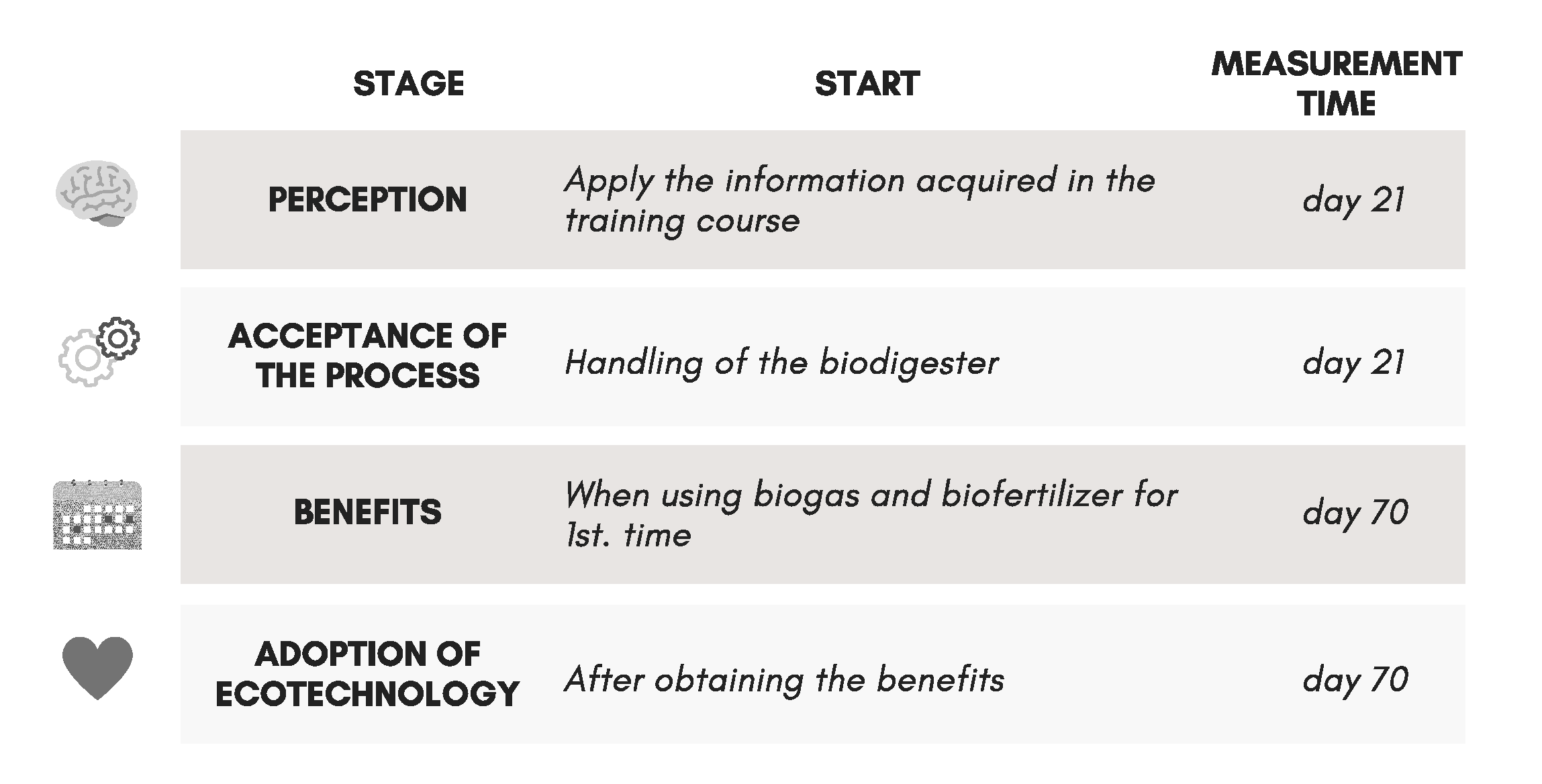
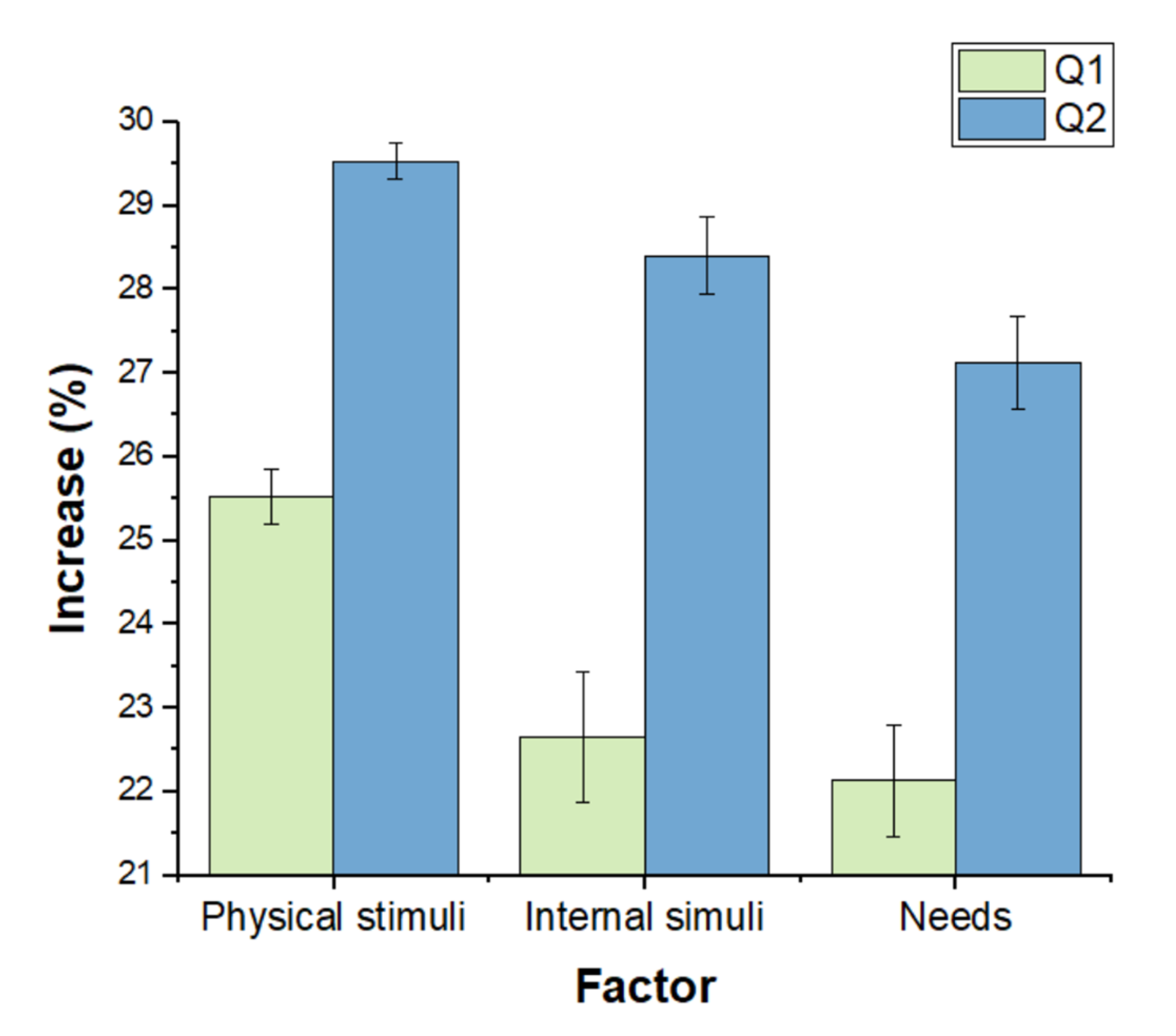


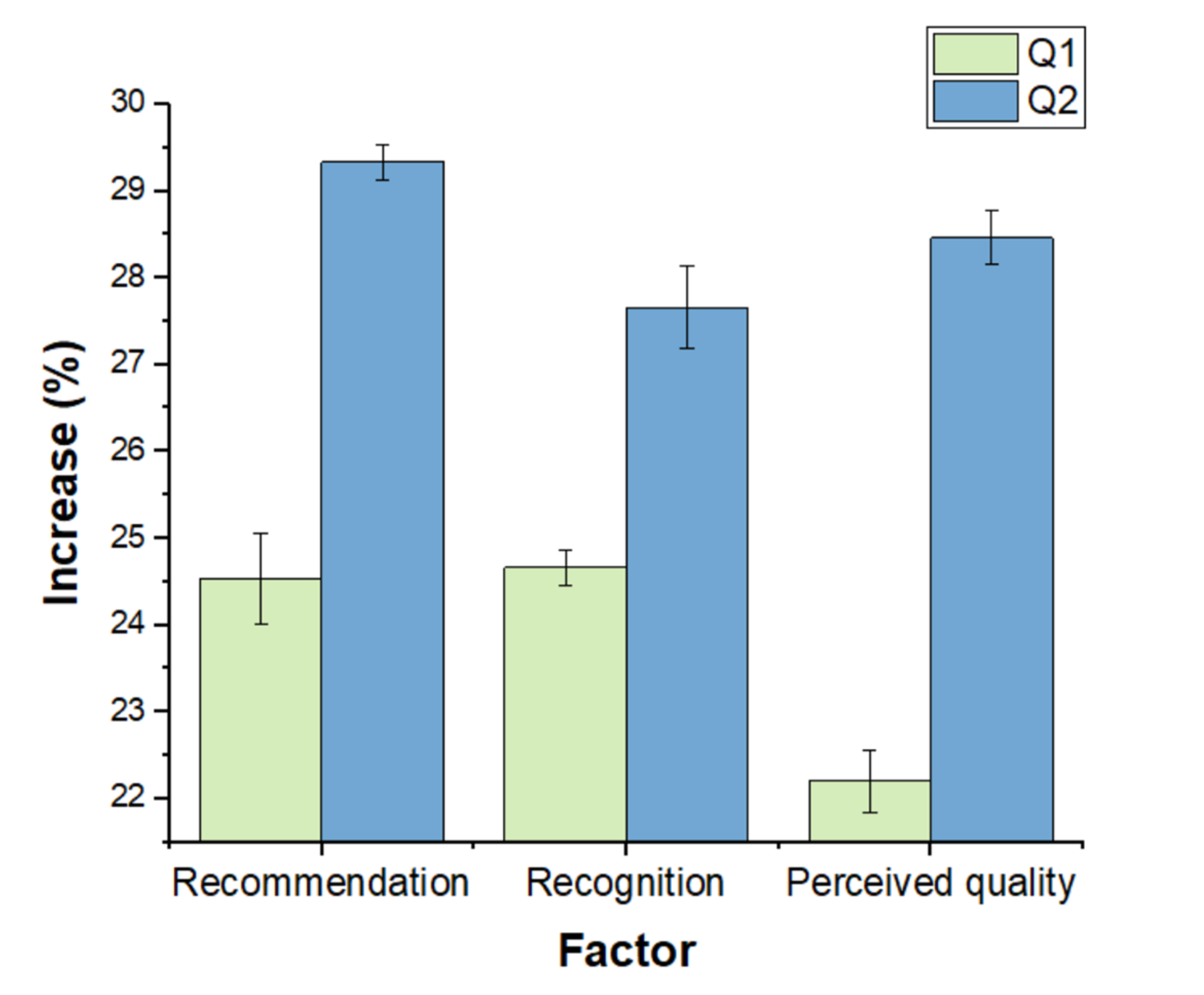
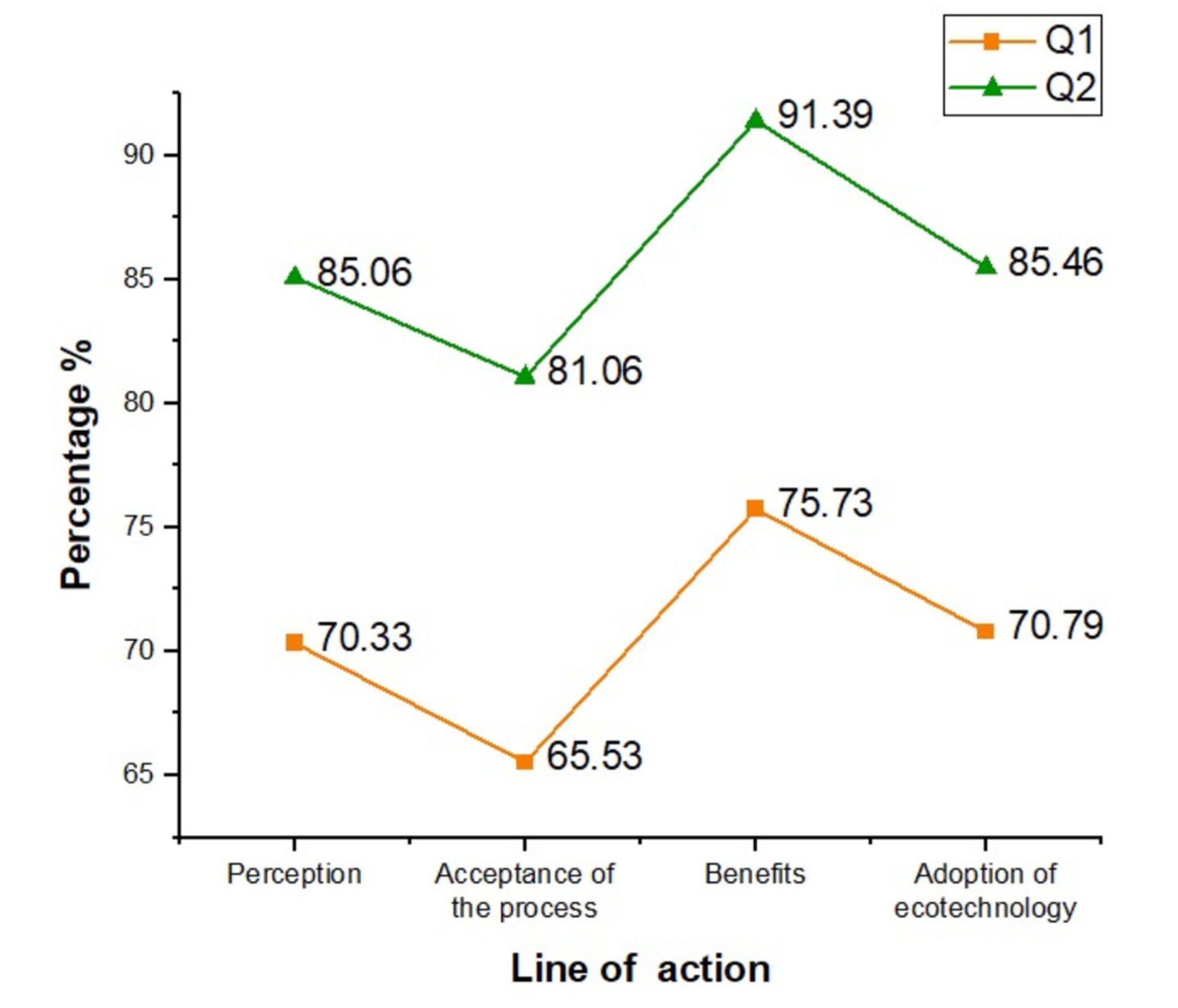
| Factor | Q1 (%) | Q2 (%) |
|---|---|---|
| Physical stimuli | 25.53 ± 0.33 | 29.53 ± 0.21 |
| Internal stimuli | 22.66 ± 0.78 | 28.40 ± 0.46 |
| Needs | 22.13 ± 0.67 | 27.13 ± 0.55 |
| Factor | Q1 (%) | Q2 (%) |
|---|---|---|
| Willingness to pay | 18.46 ± 0.51 | 25.46 ± 0.23 |
| Satisfaction in the experience | 24.53 ± 0.41 | 26.26 ± 0.82 |
| Adoption of the process | 22.53 ± 0.63 | 29.33 ± 0.29 |
| Factor | Q1 (%) | Q2 (%) |
|---|---|---|
| Economic | 29.20 ± 0.17 | 31.20 ± 0.09 |
| Social | 27.40 ± 0.93 | 30.66 ± 0.37 |
| Environmental | 19.13 ± 0.74 | 29.53 ± 0.16 |
| Factor | Q1 (%) | Q2 (%) |
|---|---|---|
| Recommendation | 24.53 ± 0.53 | 27.86 ± 0.20 |
| Recognition | 24.06 ± 0.20 | 27.66 ± 0.48 |
| Perceived quality | 22.20 ± 0.35 | 28.46 ± 0.31 |
Publisher’s Note: MDPI stays neutral with regard to jurisdictional claims in published maps and institutional affiliations. |
© 2022 by the authors. Licensee MDPI, Basel, Switzerland. This article is an open access article distributed under the terms and conditions of the Creative Commons Attribution (CC BY) license (https://creativecommons.org/licenses/by/4.0/).
Share and Cite
Flores-Nieves, M.M.; Soto-Zarazúa, G.M.; Rico-García, E.; Zamora-Castro, S.; Macías-Bobadilla, G.; Hernández-López, M.S.; Sánchez-Gutiérrez, A.E. Revaluation of Local Waste through an Ecotechnologies Strategic Plan: A Case Study with Digesters. Sustainability 2022, 14, 9389. https://doi.org/10.3390/su14159389
Flores-Nieves MM, Soto-Zarazúa GM, Rico-García E, Zamora-Castro S, Macías-Bobadilla G, Hernández-López MS, Sánchez-Gutiérrez AE. Revaluation of Local Waste through an Ecotechnologies Strategic Plan: A Case Study with Digesters. Sustainability. 2022; 14(15):9389. https://doi.org/10.3390/su14159389
Chicago/Turabian StyleFlores-Nieves, Mariana Montserrat, Genaro M. Soto-Zarazúa, Enrique Rico-García, Sergio Zamora-Castro, Gonzalo Macías-Bobadilla, Ma Sandra Hernández-López, and Arantza Elena Sánchez-Gutiérrez. 2022. "Revaluation of Local Waste through an Ecotechnologies Strategic Plan: A Case Study with Digesters" Sustainability 14, no. 15: 9389. https://doi.org/10.3390/su14159389
APA StyleFlores-Nieves, M. M., Soto-Zarazúa, G. M., Rico-García, E., Zamora-Castro, S., Macías-Bobadilla, G., Hernández-López, M. S., & Sánchez-Gutiérrez, A. E. (2022). Revaluation of Local Waste through an Ecotechnologies Strategic Plan: A Case Study with Digesters. Sustainability, 14(15), 9389. https://doi.org/10.3390/su14159389







